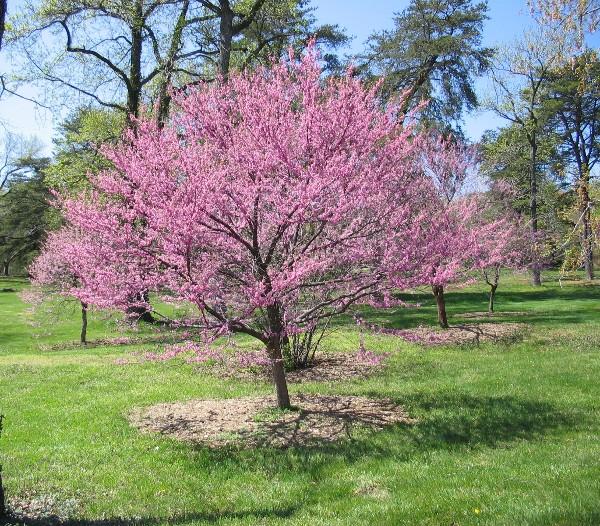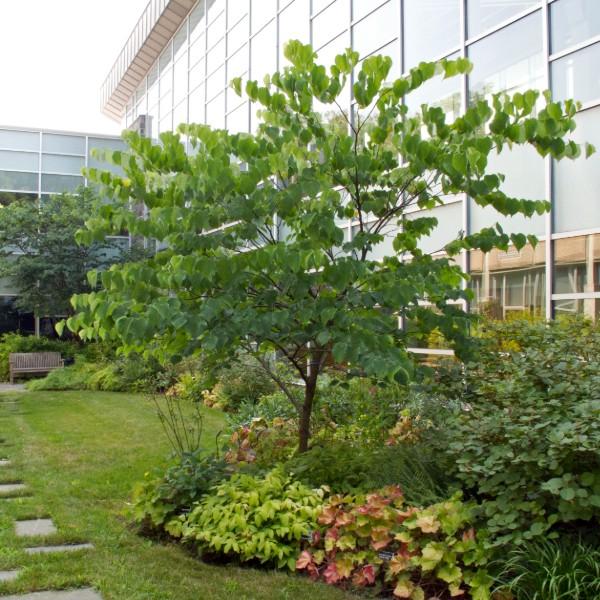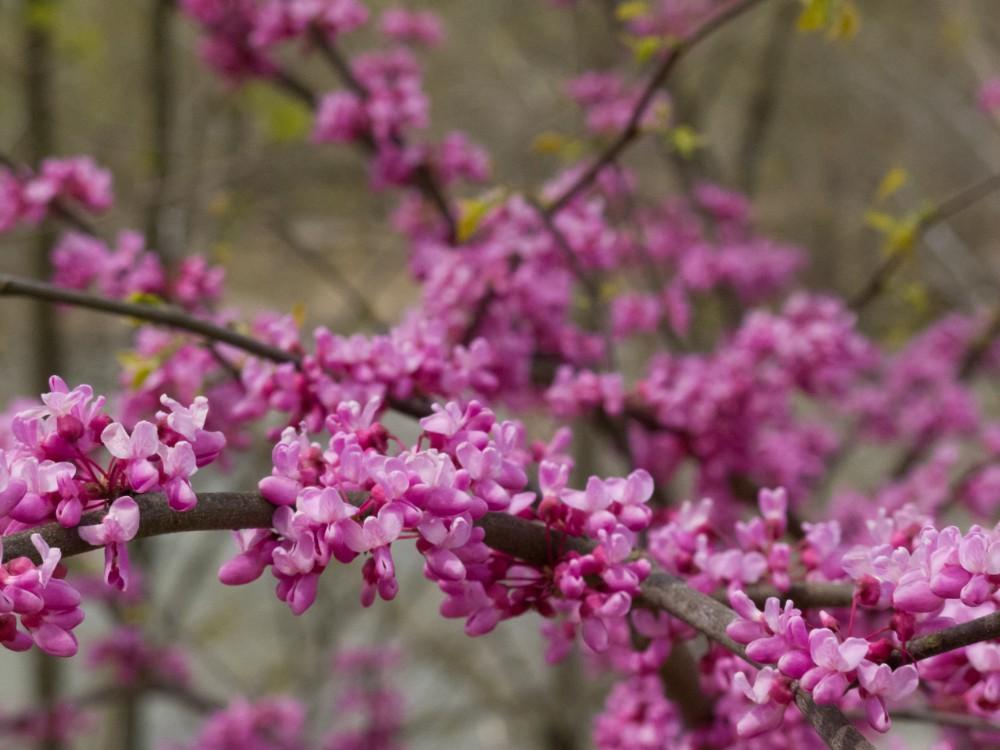About Eastern redbud
Cercis canadensis
Deciduous tree
Maryland Distribution: Maryland Piedmont, Mountain, and Coastal Plain
Height: 20’ to 35’
Flowers: Light pink to lavender, rarely white; showy, blooms April-May, self-pollinating and insect-pollinated
Fall color: Yellow
Sun: Full sun to partial shade; forest edge and understory tree
Soil: Loam-sand-clay, high organic matter; pH 4.5-7.5+
Garden Uses: Eastern redbud is native to the eastern and south-central United States and all regions of Maryland, except for a few counties nearest our Atlantic coastline. Its natural habitat includes forest edges, woodlands, and stream banks. It prefers well-drained, moist-to-occasionally dry soil. It does not tolerate wet, poorly aerated, or coarsely sandy soil conditions.
Showy pink flowers open in late spring before the leaves emerge. The heart-shaped leaves turn yellow in the fall. Pea-like seed pods are brown-black and may remain on the tree during the winter. Self-sows. Susceptible to Verticillium wilt, Botryosphaeria canker, and leaf anthracnose.
Use as a small specimen tree in a yard, woodland, or pollinator garden. This tends to be a short-lived tree (20-30 years). Plant trees in succession for replacement.
Wildlife: Many bees are supported by the nectar and pollen provided by the flowers of Eastern redbud. Some butterflies will feed on the nectar as well. This is a host plant for several species of moths, including the Io Moth and the White-Marked Tussock Moth. Some songbirds, such as Northern Cardinals, eat the seeds.


References
Eastern Redbud. Southern Research Station, Forest Service, USDA.
Slattery, Britt E., et. al. 2005. Native Plants for Wildlife Habitat and Conservation Landscaping, U.S. Fish & Wildlife, Chesapeake Bay Field Office, Annapolis, MD. 82 pp.
 English
English العربية
العربية Български
Български 简体中文
简体中文 繁體中文
繁體中文 Hrvatski
Hrvatski Čeština
Čeština Dansk
Dansk Nederlands
Nederlands Suomi
Suomi Français
Français Deutsch
Deutsch Ελληνικά
Ελληνικά हिन्दी
हिन्दी Italiano
Italiano 日本語
日本語 한국어
한국어 Norsk bokmål
Norsk bokmål Polski
Polski Português
Português Română
Română Русский
Русский Español
Español Svenska
Svenska Català
Català Filipino
Filipino עִבְרִית
עִבְרִית Bahasa Indonesia
Bahasa Indonesia Latviešu valoda
Latviešu valoda Lietuvių kalba
Lietuvių kalba Српски језик
Српски језик Slovenčina
Slovenčina Slovenščina
Slovenščina Українська
Українська Tiếng Việt
Tiếng Việt Shqip
Shqip Eesti
Eesti Galego
Galego Magyar
Magyar Maltese
Maltese ไทย
ไทย Türkçe
Türkçe فارسی
فارسی Afrikaans
Afrikaans Bahasa Melayu
Bahasa Melayu Kiswahili
Kiswahili Gaeilge
Gaeilge Cymraeg
Cymraeg Беларуская мова
Беларуская мова Íslenska
Íslenska Македонски јазик
Македонски јазик יידיש
יידיש Հայերեն
Հայերեն Azərbaycan dili
Azərbaycan dili Euskara
Euskara ქართული
ქართული Kreyol ayisyen
Kreyol ayisyen اردو
اردو বাংলা
বাংলা Bosanski
Bosanski Cebuano
Cebuano Esperanto
Esperanto ગુજરાતી
ગુજરાતી Harshen Hausa
Harshen Hausa Hmong
Hmong Igbo
Igbo Basa Jawa
Basa Jawa ಕನ್ನಡ
ಕನ್ನಡ ភាសាខ្មែរ
ភាសាខ្មែរ ພາສາລາວ
ພາສາລາວ Latin
Latin Te Reo Māori
Te Reo Māori मराठी
मराठी Монгол
Монгол नेपाली
नेपाली ਪੰਜਾਬੀ
ਪੰਜਾਬੀ Afsoomaali
Afsoomaali தமிழ்
தமிழ் తెలుగు
తెలుగు Yorùbá
Yorùbá Zulu
Zulu ဗမာစာ
ဗမာစာ Chichewa
Chichewa Қазақ тілі
Қазақ тілі Malagasy
Malagasy മലയാളം
മലയാളം සිංහල
සිංහල Sesotho
Sesotho Basa Sunda
Basa Sunda Тоҷикӣ
Тоҷикӣ O‘zbekcha
O‘zbekcha አማርኛ
አማርኛ Corsu
Corsu Ōlelo Hawaiʻi
Ōlelo Hawaiʻi كوردی
كوردی Кыргызча
Кыргызча Lëtzebuergesch
Lëtzebuergesch پښتو
پښتو Samoan
Samoan Gàidhlig
Gàidhlig Shona
Shona سنڌي
سنڌي Frysk
Frysk isiXhosa
isiXhosa